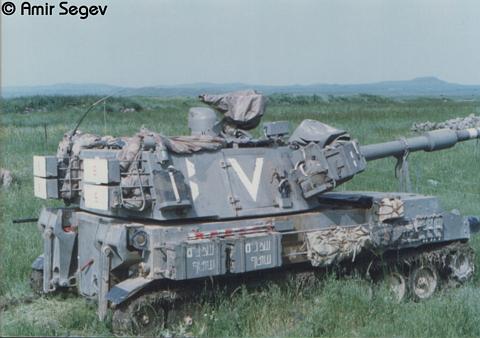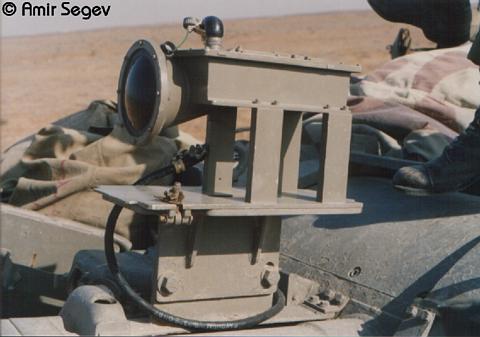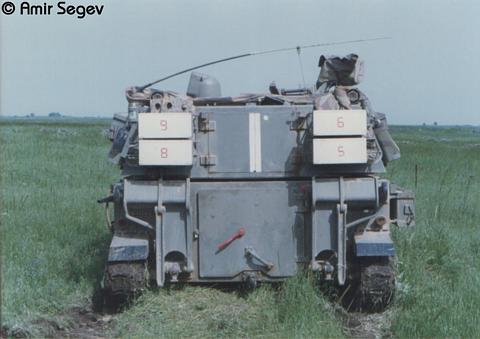|
|
|
|
|
Rochev |
| |



|
| |
| |
The M109 self-propelled Howitzer gun, known by IDF as "Rochev" (Rider), entered the Artillery forces' service before the Yom Kippur War (1973). In that war, only one battalion was equipped with these guns, the "Tiger" battalion. This battalion lost almost its entire B battery during the first days of the war. In the photos taken that time you can see the very first model, M109, with the shorter barrel, without the turret baskets and with a travel lock based in the center cover of the engine. |
|
|
|
M109A1
|
| |
The M109A1 featured a new longer barrel, and various other improvements, with a maximum range of 18,100m. The M109 was the first model, with a very short barrel, double baffle muzzle brake, large fume extractor, and a maximum range of 14,600m. |
| |
|
M109A2
|
| |
The M109A2 is a new production weapon which incorporated 27 mid-life improvements to the M109A1. The improvements provide for increased Reliability, Availability, and Maintainability (RAM) and safety characteristics as well as enhanced operational capabilities.
Major changes from the M109A1 include a redesigned rammer and improved recoil mechanism, engine operation warning devices, a redesigned hatch and door latches, an improved hydraulic system and a bustle designed to carry an additional 22 rounds of ammunition.
The M109A2 has the long tube M185 cannon installed in the M178 gun mount. The cab has a rear bustle rack which provides an increased ammunition stowage capacity. It has an all weather ballistic shield mounted over the panoramic telescope; counterbalanced travel lock and provisions for mounting the M140 alignment device.
The M109A2 entered production at BMY Combat Systems in 1978, with first deliveries made early in 1979. The first production quantity of 103 vehicles was with FY77 funding. M109A2 pro 36 M109A2s were produced for the National Guard using FY82 funds. |
| |
|
External differences M109A1 & M109A2
|
| |
The differences between the A1 & A2 models are mainly internal, for example the shells' loading system.
Three external differences can be spotted:
1. In the A1 model, the sight is covered with armored "cup", held by single bar. The "cup" can be found
either in a closed (down) position or opened (up) position. The A2 model has ballistic shield,
surrounding the sight, with a transparent window in one of its sides. The shield can be turned 360
degrees. The crewmen call this shield "The television".
2. Most of the A1 type vehicles have the old type of the barrel speedometer, mounted on the inner-upper
side of the barrel. This old type is a rectangle, with a cone in its front. Most of the A2 type vehicles
carry the advanced type, which is a rectangle without the cone (instead, it has a round pale yellow
window in its front side.
3. In A1 models, mainly those that served for training purposes, one can spot a device in the upper side
of the barrel, to carry the 0.5" SMG. This SMG was used for direct-line-of-sight training. This device
is not found in neither the A2 model, or in A5 model.. |
| |
|
Differences Rochev & Doher
|
| |
All types share the same hull, turret, barrel, engine & transmission. Most of the improvements of the Doher are internal and can't be seen from the outside: Inertial Navigating System (INS), air filtering system, and some changes in the driver's panel & cabin and NBC protection added. The external, visual differences are:
1. Two sub machine guns on the Doher's turret, only one in the Rochev. The additional SMG is
positioned near the sight ballistic shield.
2. Electrical travel lock (known in Hebrew as "BiFoot") – in the Rochev one of the crewmen has to lock
manually the barrel, most of the time the driver, with the assistance of the sight operator. In the
Doher the crewmen can do it automatically, by electrical operation. The Doher's travel lock is
thicker than the Rochev's, and has a rectangle box in its front side.
3. External Generator – the Doher is equipped with external Generator, positioned instead the right-back
basket and its two external cells. Due to the lack of one basket, the left basket is a bit bigger (to
contain the camouflage cover).
4. Different shape of the commander's turret – the Doher's NCO turret can be locked in slit position, a
position that does not exist in the Rochev.
5. Different Tactical markings – the upgraded capabilities of the Doher changed in some manners the
way the artillery battery is operated. Due to this fact, beside the different kind of V's and numbers,
one can find also a Hebrew letter (Aleph, Beit, Gimel) markings. |
| |
Most of this information provided by Amir Segev. |
|
|
| |
Crew |
7 |
Enter into service |
Early 1970's |
Armament |
155mm
7.62mm |
Ammunition storage |
45x155mm
(+ 80 on alfa truck) |
Fire Range |
18 km |
Fire Rate |
4 rds/min for 3 min
1 rd/min for 60 min |
Road range |
350 km |
Width |
3.1m |
Height |
3m |
Length |
9.1m |
Weight |
25 tons |
Speed |
50 kph |
|

|


